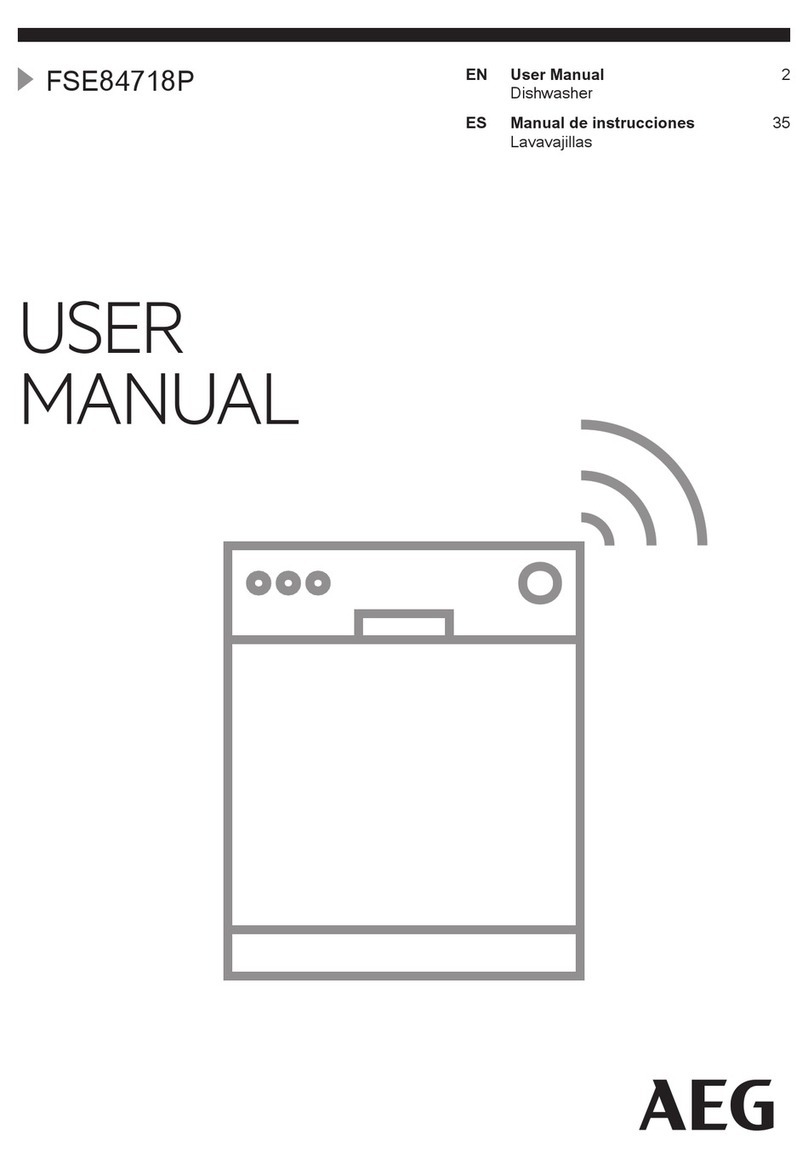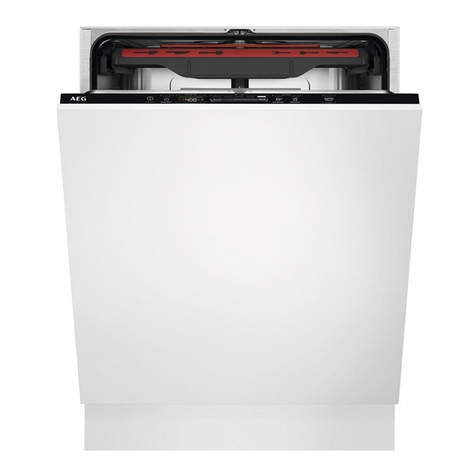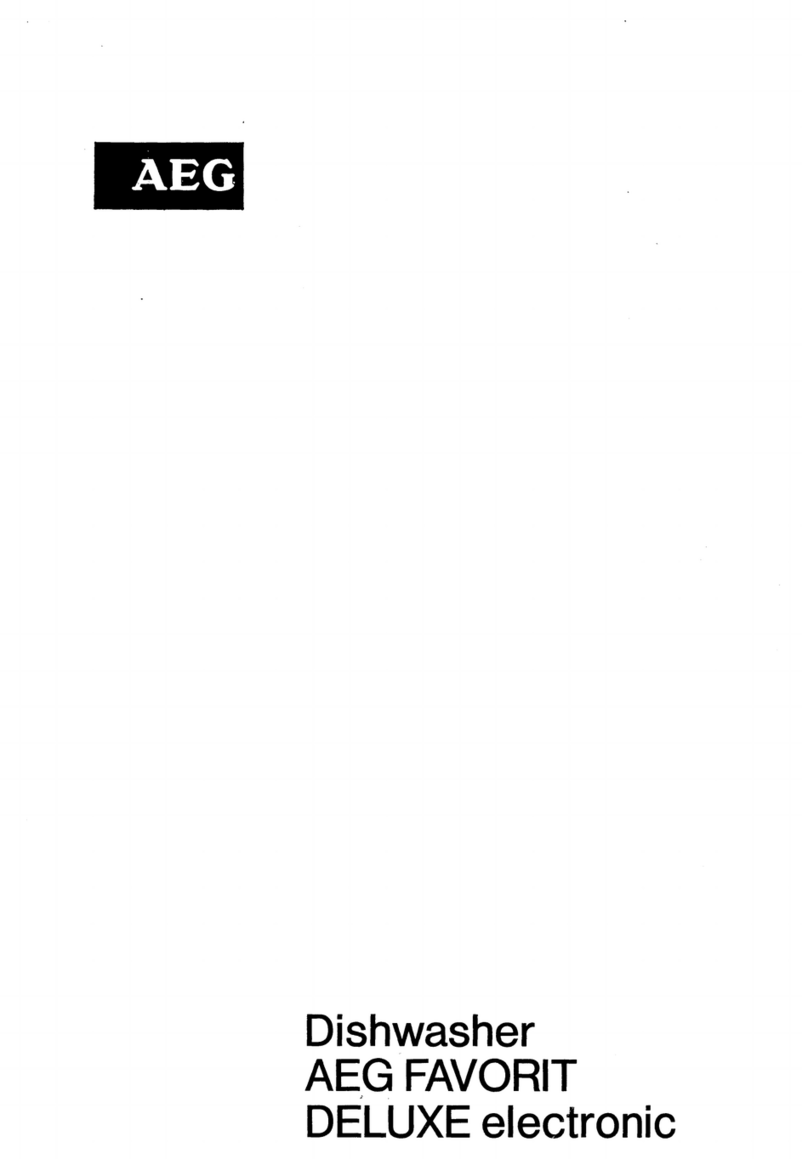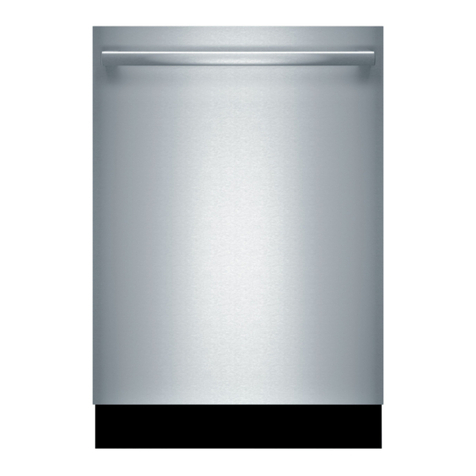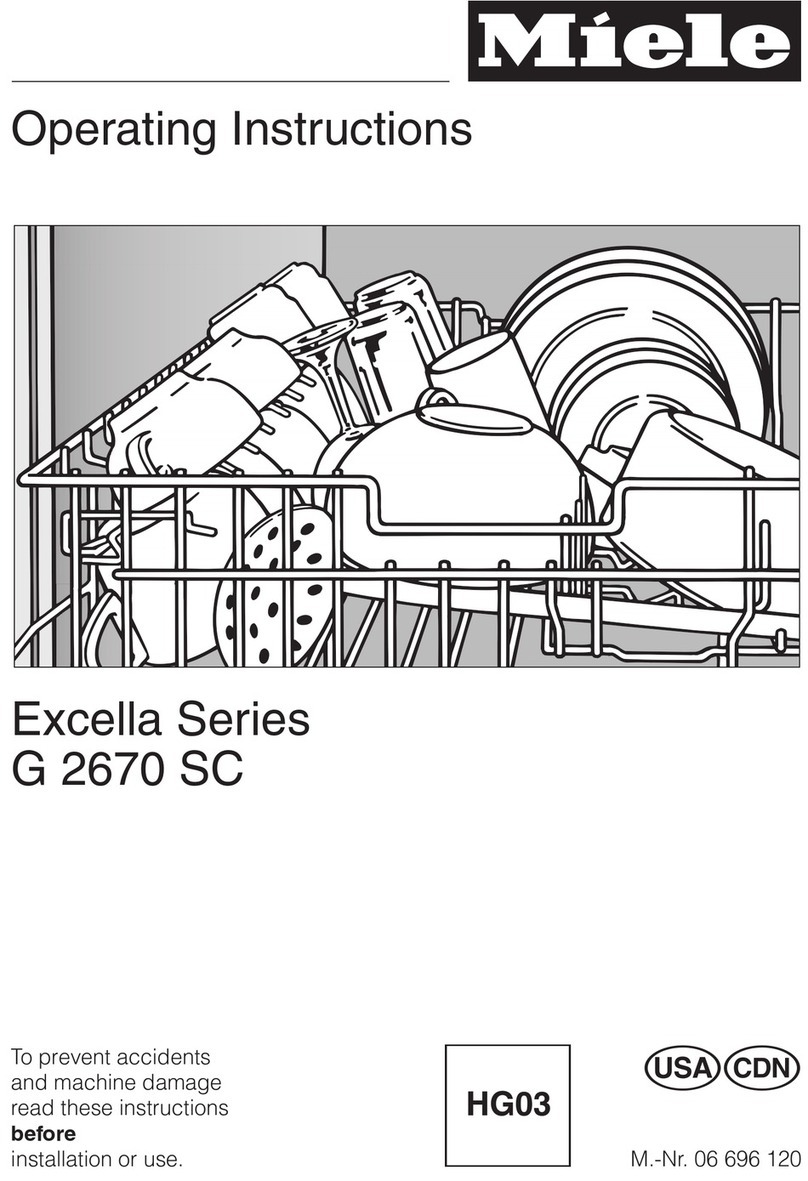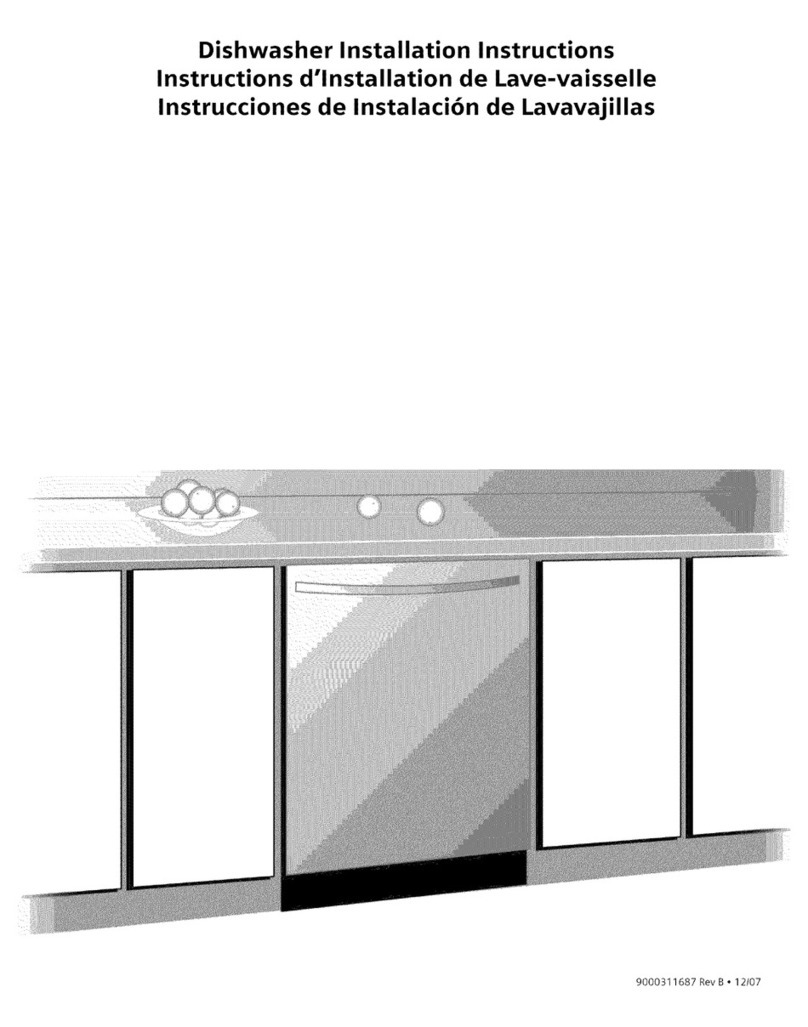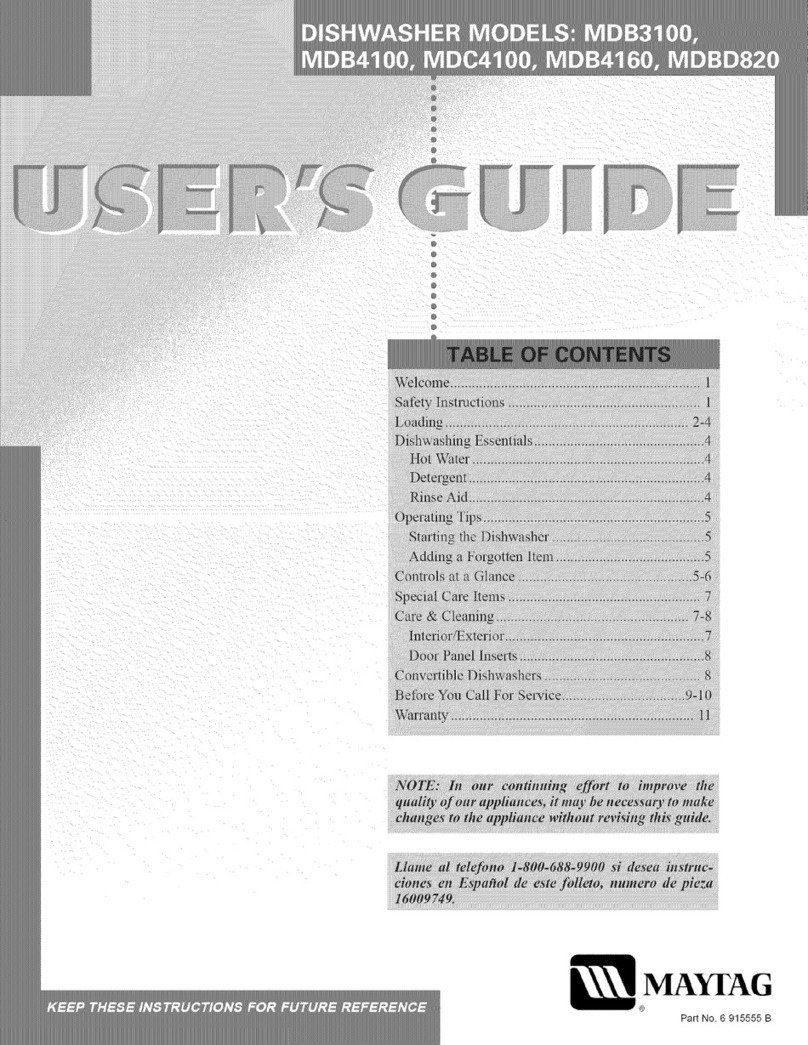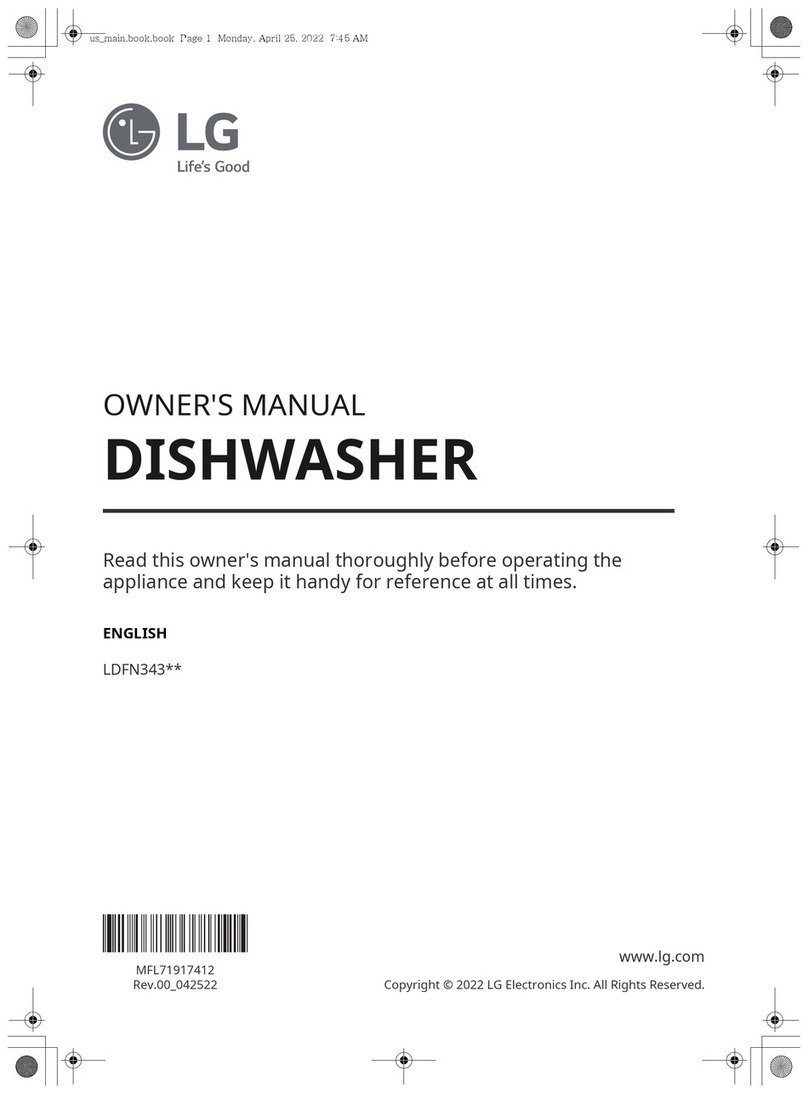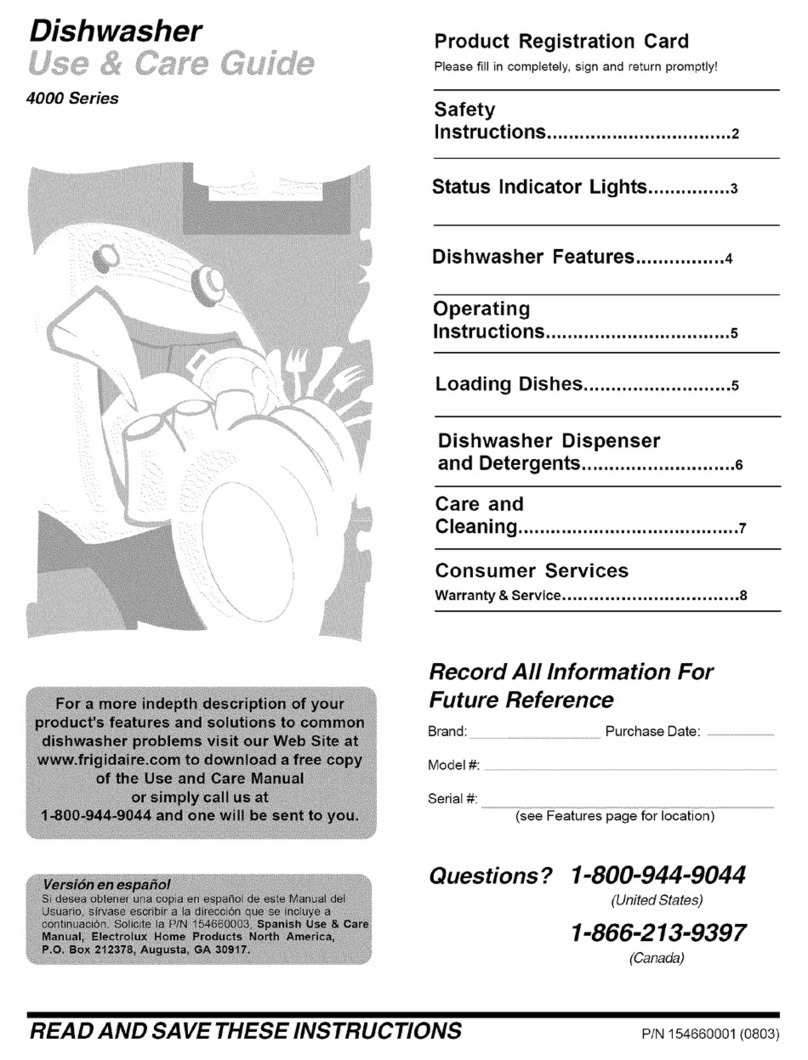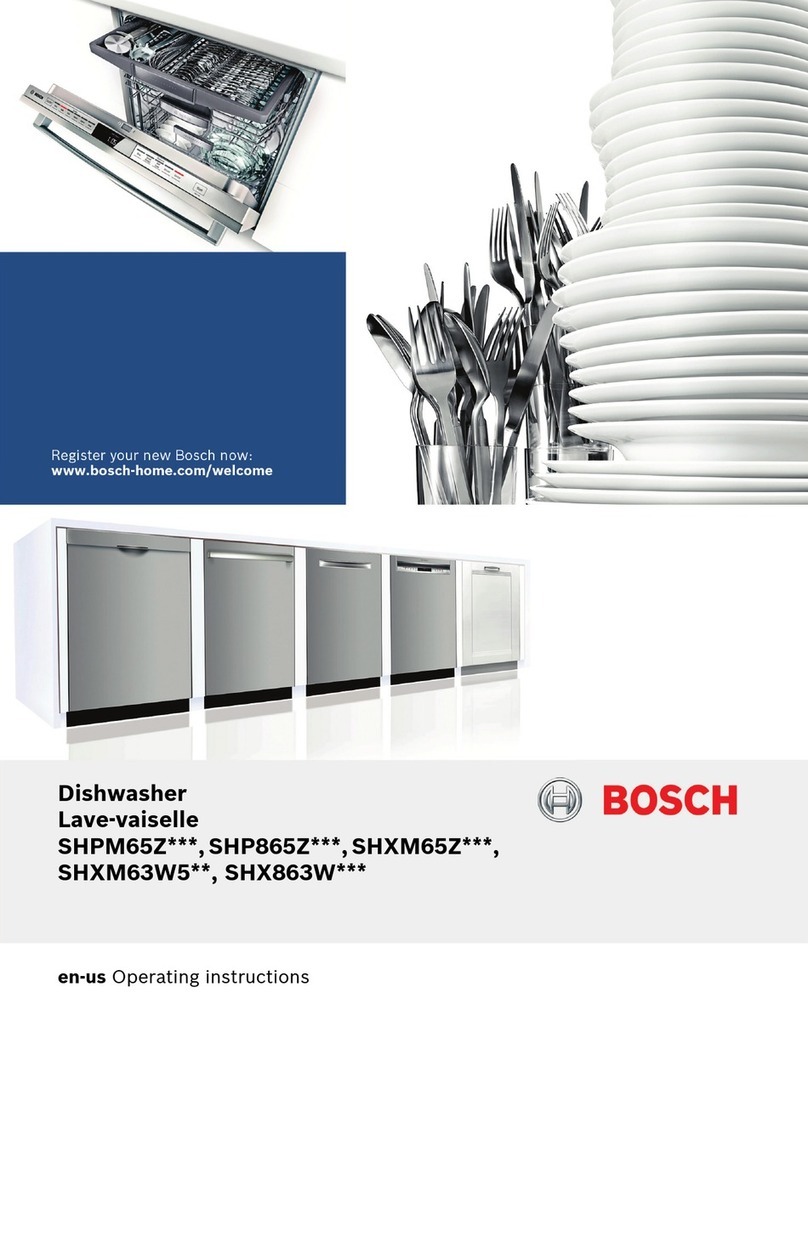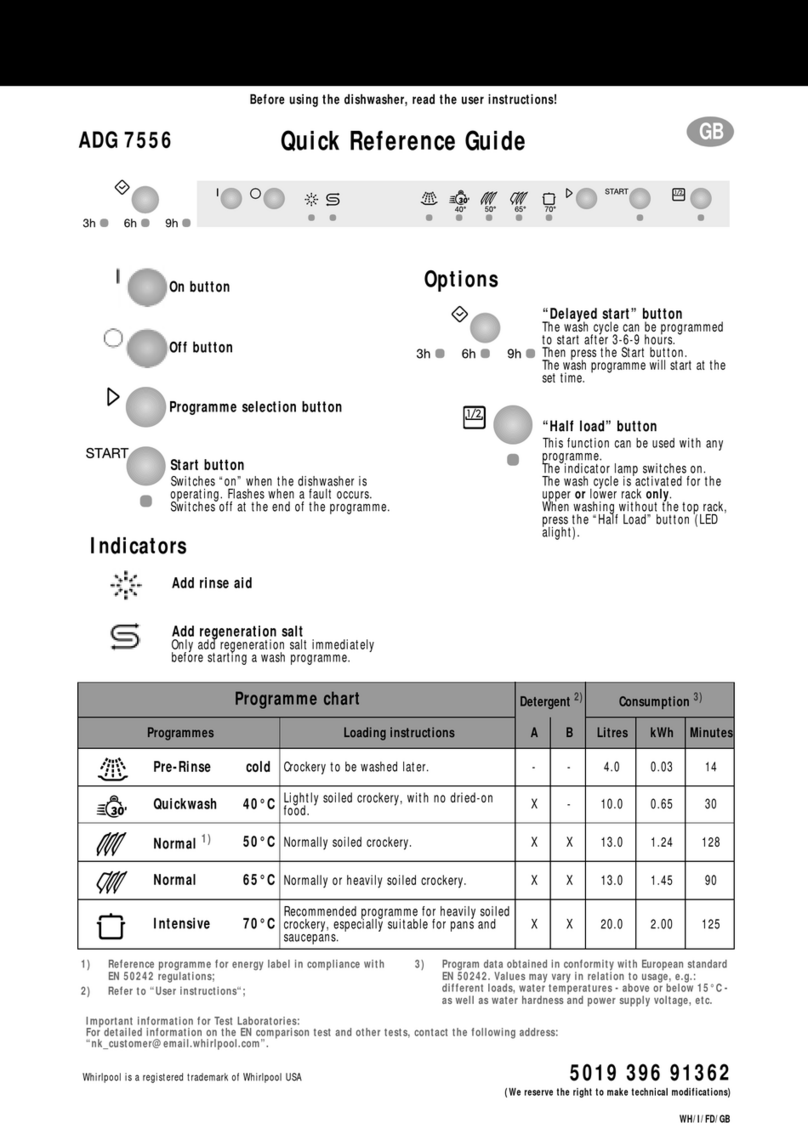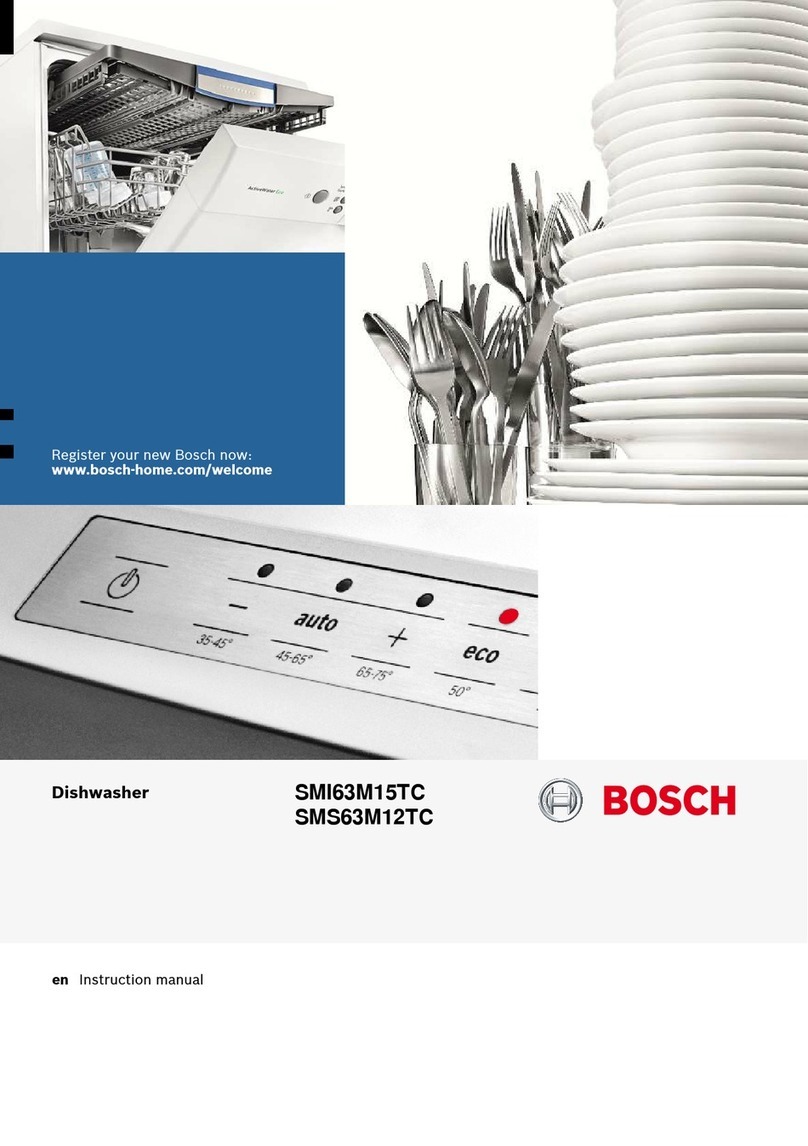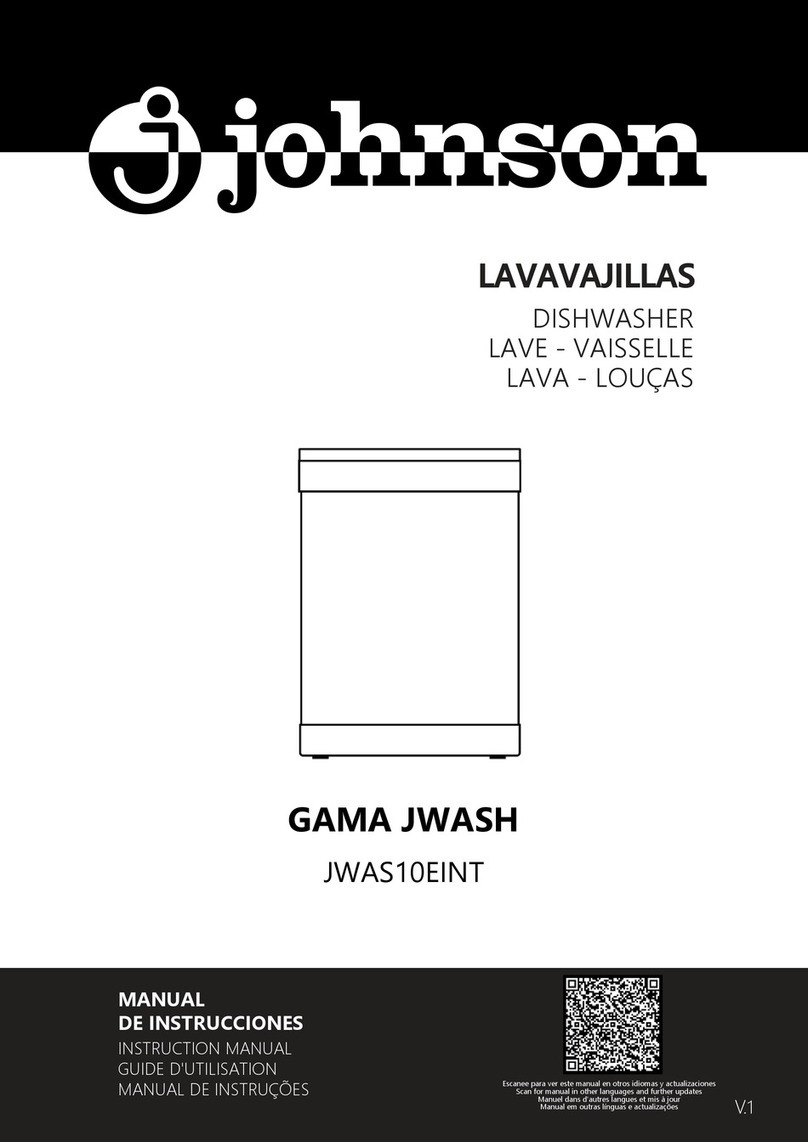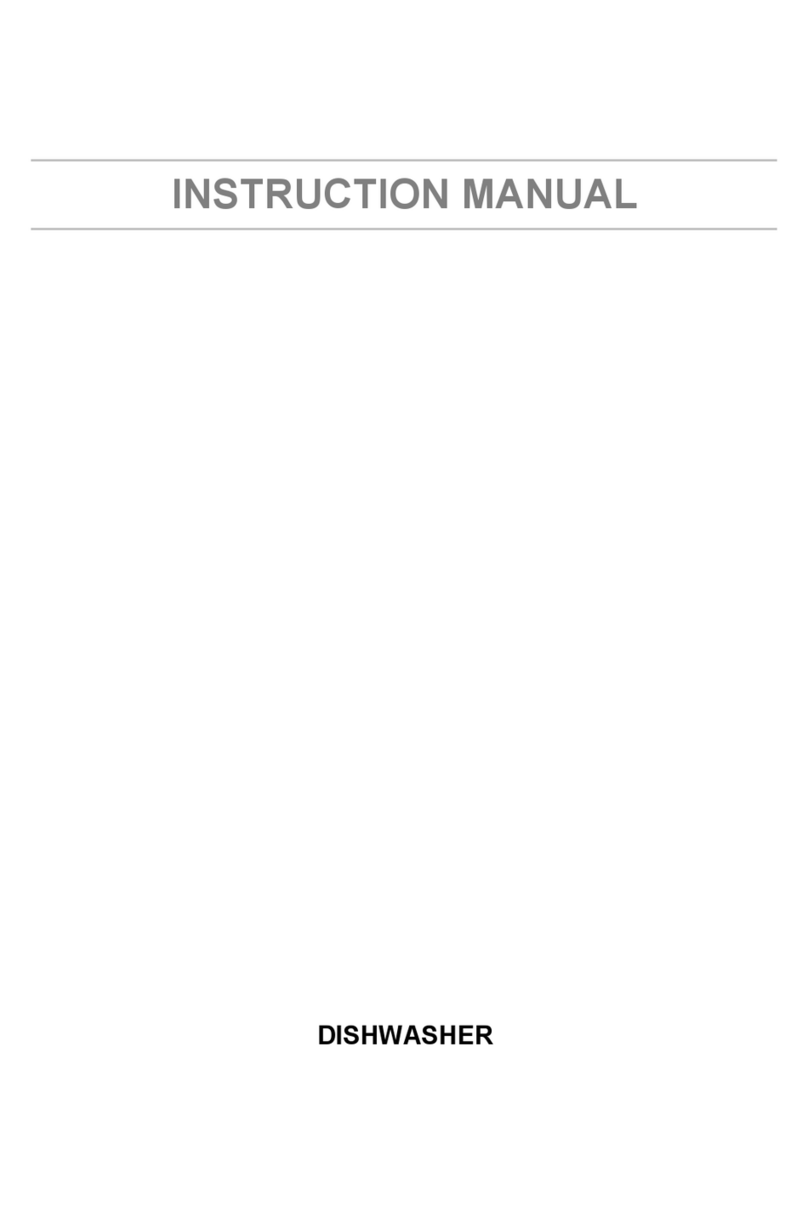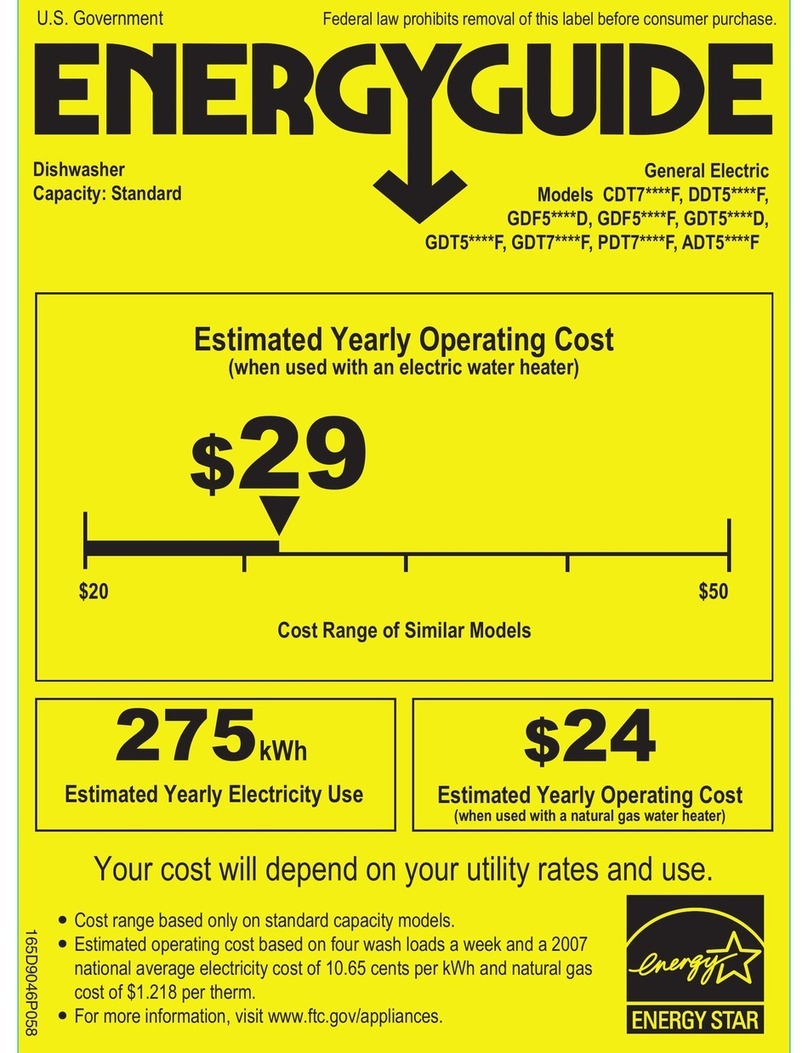AEG 645 User manual

OKO-FAVORIT
645
Dishwasher
Operating
Instructions

Read
this
instruction
booklet
and
keep
in
a
safe
place
The
dishwasher
must
only
be
installed
and
connected
by
a
specialist
fitter.
Our
special
notes
for
installation
are
given
on
pages
20-22.
The
instructions
in
this
book
will
enable
you
to
use
all
the
features
on
the
machine
to
your
best
advantage,
and
if
you
spend
a
little
time
in
following
the
instructions,
your
dishwasher
will
reward
you
with
superb
results.
If
you
do
call
out
a
service
engineer
in
connection
with
any
user
information
contained
in
this
booklet
this
call
will
not
be
free
of
charge
even
during
the
guarantee
period.
Contents
Illustrations
(unfold
pages
for
easy
reference)
3-5
Guide
to
machine
6-8
General
advice
on
dishwashing
8
Safety
information
9
Setting
the
water
hardness
10/11
Adding
dishwasher
salt
10/11
Filling
the
rinse
aid
container
11
Setting
the
rinse
aid
dosage
12
Adding
detergent
before
every
programme
12
Loading
the
dishwasher
13
Programmes
Switching
on
and
off
16
Unloading
the
diswasher
16
Cleaning
and
care
17
If
you
think
your
machine
is
not
working
properly
17/18
Service
19
For
the
plumber/electrician
(Installation,
water
and
electrical
connections,
anti-flood
system)
20-22
Technical
data
23
Loading
diagrams
5
and
23
14/15

1
i
riii
Cj^Cj
,iii)
ft??-
,A::
|
.
1
.Y
I
II
III

r
—
1
JS!
r
a
b
.
..
5
*\ti
©
b
n
ii
p
10


Guide
to
machine
For
illustrations
see
pages
3,
4,
5
Control
panel
Interior
without
baskets
Rear
Fig.
1
Fig.
2
Fig.
3
1
On,
off
and
programme
A
Lower
spray
arm
a)
Water
inlet
hose
selector
buttons
B
Salt
container
b)
Drain
hose
la
Indicators
for
depressed
C
Water
hardness
selector
c)
Electrical
lead
buttons
D
Detergent
dispenser
II
Door
handle
E
Rinse
aid
container
III
Programme
start
and
F
Filters
programme
sequence
indicator
IV
Salt
indicator
lamp
G
Rating
plate
(with
E
&
F
numbers)
On,
off
and
programme
selector
buttons
Off
and
cancel
button
1
On
button
with
illuminated
“on”
indicator
#
Rinse
and
hold
g_
65°
Intensive
programme
65
°C
s
65°
Universal
programme
65°C
6

Guide
to
machine
3=7
srzy
50°
BIO
Universal
BIO
programme
50°C
A
50°
BIO
Economy
BIO
programme
50°C
•H
50
°
Quick
wash
50
°C
Programme
sequence
indicator
(fig.
1/111)
#
Pre-wash
irniT
Wash
//!\\
Intermediate
rinsing
“,s
Final
rinse
jjL
Hot
air
drying
7

Guide
to
machine
Crockery
baskets
The
baskets
are
protected
with
polystyrene
during
transportation.
Remove
all
polystyrene
parts
before
using
the
machine.
General
advice
on
dishwashing
•
Economical
dishwashing:
Collect
the
dirty
dishes
and
stack
them
in
your
dishwasher.
Only
select
a
full
wash
programme
when
both
baskets
are
full.
A
rinse
and
hold
programme
can
be
selected
during
the
day
to
prevent
food
soil
from
drying
on
before
a
full
load
has
been
collected.
Always
select
the
programme
according
to
the
degree
of
soiling
(see
chart
on
pages
14/15).
•
"On
glaze"
decorations
may
fade
if
washed
frequently
in
the
dishwasher
over
a
long
period
of
time.
Check
earthenware
for
"dishwasher
proof”
descriptions.
•
Aluminium
articles
have
a
tendency
to
dis¬
colour
when
machine
washed.
•
Some
glassware
may
not
be
suitable
for
machine
washing.
Etching
could
occur
leaving
the
glasses
dull
and
opaque
in
appearance.
•
Clean
food
residues
on
silver
dishes
and
silver
cutlery
if
you
do
not
run
a
wash
pro¬
gramme
after
the
meal
(some
food
such
as
egg
white,
egg
yolk,
mustard,
etc.,
cause
stains
and
discolouration).
•
Unsuitable
articles:
Wooden
chopping
boards,
heat
sensitive
plastic
articles,
pewter,
crockery
repaired
with
glue,
cracked
china,
old
cutlery,
steel
knives
sensitive
to
rust,
cutlery
with
wood,
bone,
china
and
mother-of-pearl
handles.
•
If
in
doubt
about
an
article
check
with
the
manufacturer
of
the
article
where
possible.
Failing
this,
wash
valuable
items
by
hand.
•
When
buying
new
china
look
out
for
dish¬
washer
suitable
crockery,
cutlery
and
glasses.
Buy
articles
which
have
straight
and
smooth
sides,
large
openings
avoiding
deep
indentations
on
the
base
of
the
crockery.

Safety
Information
•
This
is
a
domestic
dishwasher
for
domestic
use
only.
It
must
only
be
used
for
washing
articles
recommended
by
the
manufacturer
for
dishwashing
by
machine
and
then
fol¬
lowing
the
instructions
contained
in
this
booklet.
The
machine
must
be
installed
and
cared
for
and
maintainted
as
instructed
in
this
instruction
booklet,
any
installation
instructions
and
any
supplementary
instructions
supplied
with
the
machine.
Any
other
use,
installation,
maintenance
may
lead
to
damage
to
the
machine,
persons
or
property
for
which
the
manufacturer
of
the
machine
does
not
accept
any
responsi¬
bility.
•
Do
not
stack
plastic
articles
over
the
heat¬
ing
element.
When
stacking
lightweight
plastic
articles
weigh
them
down
with
other
heavier
items
to
prevent
them
from
being
shifted
and
falling
on
to
the
heating
ele-
•
Do
not
touch
the
heating
element
immedia¬
tely
after
a
wash
cycle
is
completed.
•
Only
use
dishwasher
detergents
which
are
recommended
for
domestic
dishwashers.
•
Store
dishwasher
detergents
in
a
safe
place
-
away
from
children.
These
deter¬
gents
can
cause
serious
injuries
to
the
throat
or
can
lead
to
suffocating
when
swallowed.
Keep
children
away
from
dish¬
washers,
detergent
residues
may
still
be
in
the
machine.
•
Do
not
use
any
solvents
in
the
dishwasher
-
risk
of
explosion.
•
The
water
in
the
dishwasher
is
not
drinking
•
Children
cannot
foresee
the
consequences
of
tampering
with
electrical
appliances.
Do
not
leave
children
unsupervised
when
machines
are
in
operation.
•
Children
must
not
play
inside
the
dish-
•
Do
not
sit
or
stand
on
the
open
door
of
the
dishwasher.
The
machine
may
tip
over.
•
The
water
inlet
hose
with
a
plastic
con¬
tainer
at
the
water
feed
end
contains
an
electrical
lead
for
a
valve.
Do
not
cut
the
hose.
Do
not
dip
this
container
into
water.
•
In
case
of
a
fault,
turn
off
the
water
supply
tap
and
switch
off
the
appliance
and
pull
the
plug
out
of
the
electrical
supply
socket.
•
When
this
appliance
is
finally
replaced
by
machine,
cut
off
the
electrical
lead
and
dispose
of
it
safely
to
prevent
children
playing
with
the
machine
and
endangering

Setting
the
water
hardness
-
adding
dishwasher
salt
Your
dishwasher
is
equipped
with
a
water
softener
which
transforms
the
“hard”
water
into
“soft”
water
required
for
washing.
To
re¬
generate
the
water
softener
the
salt
container
in
the
bottom
of
the
wash
tub
(fig.
2/B)
must
contain
dishwasher
salt
at
all
times.
At
the
end
of
each
programme
the
water
softener
is
auto¬
matically
re-generated
using
some
of
the
salt
from
the
salt
container.
For
economical
reasons
and
to
protect
the
environment
do
not
use
more
salt
than
neces-
Please
also
make
reference
to
special
instruc¬
tions
found
on
the
detergent
packaging.
Set
the
water
hardness
selector
(fig.
2/C
and
fig.
4)
to
the
correct
setting
using
a
coin.
Your
local
Water
Authority
will
quote
the
water
hardness
in
English
or
Clarke
Degrees
or
parts
per
million
(ppm).
Water
hardness
Setting
of
the
water
hardness
selector
hardness
English
or
Clarke
Deg.
PPM
IV
42-49
610-720
33-42
490-600
@
26-33
380-480
-
17-26
267-373
@
II
10-17
142-249
1
Below
10
Below
142
No
salt
required
*)
Factory
set

Setting
the
water
hardness
-
adding
dishwasher
salt
The
salt
you
require
is
special
salt
suitable
for
domestic
dishwashers.
On
no
account
should
table
salt,
cooking
salt,
road
salt
or
processed
sea
salt
be
used,
because
they
contain
substances
adversely
affecting
the
water
softener.
Important!
Detergents
and
salt
are
very
often
available
in
very
similar
looking
packaging.
Take
care
that
you
DO
NOT
fill
the
salt
con¬
tainer
with
detergent,
IT
RENDERS
THE
WATER
SOFTENER
INEFFECTIVE.
The
salt
container
filler
neck
is
situated
on
the
right
hand
side
on
the
bottom
of
the
wash
tub
(fig,
2/B).
To
fill
the
container
-
open
the
door,
lift
out
the
lower
basket,
unscrew
the
cap
marked
$=5
and
place
the
funnel
supplied
with
the
machine
over
the
opening
(fig.
5).
Before
the
first
use
only,
pour
1.5
to
2
litres
(3-4
pints)
of
water
into
the
salt
container.
Then
add
the
salt
until
it
is
visible
at
the
top
of
the
container
(capacity
approx.
1.5
Kg).
During
the
filling
process,
some
water
is
displaced.
Remove
any
spilled
salt
from
the
filler
neck
and
replace
the
cap
firmly.
Replace
the
lower
basket.
Important!
To
prevent
salt
from
entering
the
washing
cycle
close
the
cap
to
the
salt
container
firmly.
Cloudy
glassware
may
result
from
salt
getting
into
the
washing
water.
No
salt
residues
must
be
left
on
the
bottom
of
the
tub.
To
ensure
that
all
salt
residues
are
removed,
select
a
rinse
and
hold
programme
or,
a
complete
wash
programme
if
you
have
enough
dirty
crockery,
after
the
salt
container
has
been
filled.
To
replenish
the
salt
container
Replenish
the
salt
container
when
the
lamp
above
Symbol
!=s
on
the
control
panel
(fig.
1/IV)
is
on.
Please
note
For
water
hardness
area
1
-
see
page
10,
no
salt
is
required
and
symbol
(=3
will
light
up
every
time
the
machine
is
switched
on.
Please
ignore
the
light
in
this
particular
instance
-
it
does
not
affect
the
operation
of
the
machine.
Filling
the
rinse
aid
container
Rinse
aid
is
dispensed
automatically
during
the
final
hot
rinse.
It
prevents
water
drops
from
clinging
to
the
crockery
and
gives
the
final
sparkle
to
the
china
and
glassware.
Important!
Use
only
rinse
aids
suitable
for
domestic
dishwashers
-
we
recommend
Finish.
Never
use
normal
washing
up
liquids.
These
have
high
sudsing
properties
and
are
unsuit¬
able
for
dishwashers.
You
will
find
the
rinse
aid
container
on
the
inside
of
the
door
(fig.
2/E).
Open
the
contain¬
er
by
turning
the
lid
a
quarter
turn
to
the
left
(fig.
7/arrow)
and
slowly
pour
rinse
aid
into
the
filler
neck
up
to
the
dotted
line
(fig.
8).
Replace
the
lid
and
close
by
turning
it
clock¬
wise.
The
container
will
take
approx.
150cc,
which
will
last
for
approx.
50
programmes.
Wipe
off
any
spilled
rinse
aid
to
prevent
excess
foaming
during
the
next
wash
cycle.
Rinse
aid
refill
indicator
Replenish
the
rinse
aid
container
when
the
,
level
indicator
window
(fig.
8)
shows
a
dark
dot
surrounded
by
a
lighter
circle
(©).
When
the
container
is
full
the
window
is
darker
in

Adjusting
the
rinse
aid
dosage
The
adjuster
to
alter
the
quantity
of
rinse
aid
being
dispensed
is
located
in
the
filler
neck
(fig.
9).
The
quantity
can
be
varied
from
1-6cc
and
the
corresponding
numbers
are
shown
on
the
adjuster.
To
alter
the
setting,
move
the
arrow
to
another
setting
using
a
screwdriver
or
coin.
The
machine
is
set
to
dispense
3
cc
rinse
aid
(arrow
is
set
to
“3")
automatically
during
the
final
rinse.
Do
not
alter
the
setting
unless
it
becomes
necessary
(see
page
17/18
“If
you
think
your
machine
is
not
working
properly...”).
Add
dishwasher
detergent
before
every
wash
programme
Before
you
start
a
wash
programme
(except
rinse
and
hold
programme)
fill
detergent
dispenser
with
detergent
(fig.
2/D).
If
the
dispenser
is
closed,
push
the
locking
catch
(fig.
10/a)
and
the
lid
springs
open.
The
amount
of
detergent
to
use
depends
on
the
degree
of
soiling
of
the
utensils
to
be
washed.
For
light
soiling
you
will
require
approx.
20
ml,
for
normal
to
heavy
soiling
approx.
30
ml.
When
using
liquid
detergents
use
approx.
30
ml
and
40
ml
respectively.
To
help
you
use
the
correct
amount
of
detergent
the
dispenser
is
marked
“Min”
(approx.
20
ml)
and
"Max”
(approx.
30
ml)
(fig.
11).
Close
the
lid
of
the
dispenser
and
press
until
it
snaps
shut.
The
detergent
is
automatically
dispensed
at
the
correct
stage
of
the
programme.
We
would
recommend
filling
the
compartment
in
the
lid
(fig.
10/b)
level
to
the
top
with
deter¬
gent
for
all
programmes
which
include
a
pre-
As
effectiveness
of
detergents
differs
from
one
make
to
another,
follow
also
the
recom¬
mendations
of
the
detergent
manufacturers.
Useful
hints:
The
“Min”
and
“Max"
markings
in
the
deter¬
gent
dispenser
apply
to
full
loads
which
is
the
most
economical
way
of
machine
washing.
If
you
want
to
wash
smaller
loads,
15
ml
of
detergent
(approx.
25
ml
liquid
detergent)
is
sufficient
to
obtain
an
excellent
wash
result
Important!
•
Only
use
detergents
for
domestic
dish¬
washers.
Never
use
washing
up
liquids
(they
cause
excessive
foaming
and
the
dishes
are
not
cleaned).
•
Always
close
the
detergent
pack
and
store
in
a
dry
place
(lumpy
detergent
has
lost
its
cleaning
power).
•
Always
use
the
recommended
amount
of
detergent.
If
you
use
too
little,
starch
deposits
will
remain
on
the
dishes
which
can
only
be
rubbed
off
by
hand.
There
are
two
types
of
dishwasher
detergents
on
the
market,
the
conventional
type
and
the
ultra
compact
cleaners.
When
using
an
ultra
compact
cleaner
we
recommend
you
select
a
BIO
50
X
pro¬
gramme.
This
BIO
programme
was
specially
developed
for
the
compact
cleaners.
The
cleaning
effect
of
the
Universal
BIO
50X
or
the
Economy
50
X
BIO
programme
using
ultra
compact
cleaners
can
be
compared
to
using
the
Universal
65
X
or
Economy
65
X
programme
with
conventional
detergents.
The
BIO
programme
has
the
added
benefit
that
your
crockery
is
treated
in
a
gentler
fashion
due
to
the
lower
wash
temperature
and
the
absence
of
corrosive
substances.
12

Loading
the
machine
Before
you
load
the
machine
remove
any
remaining
food
and
bones
from
the
plates
and
soak
saucepans
with
burnt
on
food
as
you
would
when
washing
up
by
hand.
The
easiest
way
to
load
a
basket
is
from
back
to
front.
Lower
basket
(fig.
12):
Large
heavily
soiled
dishes
are
best
cleaned
in
the
lower
basket.
Pull
out
the
lower
basket
as
far
as
the
stops
and
stack
it
with
large
items:
plates,
serving
dishes,
serving
plates
and
saucepans
as
illustrated.
Cutlery
basket:
Arrange
the
cutlery
as
follow:
•
Distribute
the
unsorted
cutlery
loosely
in
all
basket
compartments
so
that
each
item
is
reached
by
the
wash
water.
•
Knife,
fork
and
spoon
handles
down
for
best
results.
•
Make
sure
spoons
and
forks
do
not
stick
together.
Use
the
special
holder
for
tea
and
coffee
spoons.
•
Lay
long
handled
utensils
such
as
a
soup
ladle
flat
in
the
top
basket
to
avoid
block¬
ing
the
upper
spray
arm.
Top
basket
(fig.
13):
Smaller,
more
fragile
items
are
washed
gently
in
the
top
basket.
Pull
out
the
top
basket
as
far
as
the
stop
to
arrange
the
smaller
items
such
as
saucers,
cups
and
glasses
as
illus¬
trated.
You
can
also
use
the
fold
down
racks
Important!
By
arranging
the
dishes
correctly
you
will
ensure
a
satisfactory
wash
result
•
Stack
cups,
glasses,
saucepans,
etc.,
upside
down
so
that
the
water
can
run
off
freely.
•
Thick
and
curved
plates
and
similar
items
should
be
placed
in
the
bottom
basket
on
the
left
where
the
racks
are
wider
so
that
each
item
is
reached
by
the
wash
water.
•
Bowls,
saucepans
and
frying
pans
are
well
positioned
upside
down
over
the
short
racks
in
the
lower
basket.
•
Load
glasses
so
that
they
do
not
touch
each
other
(to
prevent
stains
and
break¬
ages).
•
When
stacking
items
under
the
folding
racks
in
the
upper
basket
make
sure
that
the
water
sprays
can
reach
both
layers.
Top
basket
-
height
adjustment
The
height
of
the
top
basket
is
adjustable.
Top
basket
in
top
position:
Loading
height
in
top
basket:
20
cm,
lower
basket:
29
cm.
Top
basket
in
lower
position:
Loading
height
in
top
basket:
25
cm,
lower
basket:
24
cm.
The
top
basket
has
been
slotted
into
the
top
position
at
the
factory.
If
you
wish
to
adjust
the
height
of
the
top
basket
proceed
as
follows:
1.
Pull
the
top
basket
forward
to
the
stop
position.
2.
Remove
the
basket
retainers
(fig.
14)
at
the
front
of
the
basket
rails.
3.
Remove
the
basket
from
the
machine.
4.
Insert
the
upper
or
the
lower
rollers
into
the
rails
(upper
rollers
=
lower
position
of
top
basket,
lower
rollers
=
top
position
of
top
basket).
5.
Refit
the
basket
retainers.
13

Programme
chart
Programmes
Suitable
for:
Setting
the
programme:
Turn
start/indi-
Press
on/off
cator
switch
and
programme
to
symbol:
button:
Rinse
and
Rinsing
heavily
soiled
items
which
are
not
washed
immediately
A
1
#
Intensive
65
°C
Heavily
soiled
china
and
saucepans
with
dried
on
food
deposits
(particularly
protein
A
l
a
65°
Universal
65
°C
Normally
to
heavily
soiled
china
and
saucepans
with
dried
on
food
deposits
(particularly
vegetables
such
as
spinach,
carrots,
starch,
etc.)
A
1
s
65°
Universal
BIO
50
°C
Normally
soiled
crockery
and
temperature
sensitive
items
(e.
g.
glass,
plastic
ware).
Recommended
for
use
with
Ultra
Compact
cleaners
to
achieve
the
optimum
cleaning
A
1
s
50°
BIO
Quick
wash
BIO
50
°C
Normally
to
lightly
soiled
crockery
and
glasses.
Recommended
for
use
with
Ultra
Compact
cleaners
to
achieve
the
optimum
cleaning
B
1
A
50°
BIO
Quick
wash
50
°C
Full
load
Normally
to
lightly
soiled
crockery
and
glasses
B
1
H
50°

Programme
chart

Switching
on
(programme
chart
-
see
previous
page)
1.
Fully
open
the
water
tap.
Important:
If
the
dishwasher
was
started
but
the
water
tap
had
not
been
opened,
switch
off
the
machine,
fully
open
the
water
tap,
switch
on
the
machine
and
start
the
programme
again.
2.
Turn
the
start/indicator
switch
(fig.
1/111)
clockwise
to
symbol
A
or
B.
3.
Press
the
on
button
and
the
programme
button
required
(fig.
1/1).
The
machine
“on”
light
is
on
and
the
red
programme
indicator
above
the
selected
programme
is
also
on.
The
programme
Programme
sequence
indicator
(fig.
1/111)
After
the
machine
has
been
started
the
pro¬
gramme
indicator
passes
through
the
various
stages
automatically,
indicating
each
stage
The
indicator
stops
temporarily
during
the
wash
and
the
final
rinse
until
the
water
has
reached
the
required
temperature.
Programme
correction
If
you
have
selected
the
wrong
programme
by
mistake,
simply
turn
the
start/indicator
switch
to
the
correct
setting
and/or
press
the
correct
programme
button.
Warning!
Before
turning
the
start/indicator
switch,
switch
off
the
machine
to
prevent
det¬
ergent
being
released
into
the
machine
by
mistake.
The
machine
should
also
be
switched
off
due
to
radio
interference
suppression
requirements.
Switching
off
-
unloading
the
machine
The
dishwasher
switches
off
automatically
when
the
programme
is
finished.
•
Press
the
off
button.
The
machine
“on"
light
goes
out.
•
Wait
approx.
15
minutes
before
unloading
the
machine
to
allow
everything
to
dry
completely.
If
the
crockery
is
not
removed
at
that
stage,
open
the
dishwasher
door
and
leave
it
slightly
ajar.
To
speed
up
the
drying
phase,
you
can
open
the
door
com¬
pletely
and
then
leave
it
slightly
ajar
(steam
will
escape
from
the
machine).
This
is
only
recommended
if
the
underside
of
your
worktop
has
been
protected
with
the
alu¬
minium
foil
strip
supplied
with
the
machine.
•
Empty
the
lower
basket
first
and
then
the
upper
basket.
This
prevents
any
water
which
may
have
collected
in
recessed
or
curved
items
in
the
upper
basket
from
dripping
onto
crockery
in
the
lower
basket.
•
Check
the
filters
after
every
programme.
If
they
are
dirty
clean
them
as
per
instruc¬
tions
on
page
17.

Cleaning
the
filters
Coarse
filter
(fig.
15)
Remove
the
coarse
filter
and
brush
it
clean
under
running
water.
Check
the
lower
half
of
this
filter
also
and
remove
the
food
residues
which
may
be
trapped
there.
Note
that
the
upper
cylindrical
section
of
the
coarse
filter
can
be
lifted
out
(fig.
16).
When
replacing
ensure
that
the
upper
section
sits
straight
and
tight
before
re-inserting
the
coarse
filter.
Fine
filter
(fig.
17)
Clean
the
fine
filter
(a)
and
microfilter
(b)
as
and
when
necessary.
To
remove
the
fine
filter
turn
it
anticlockwise.
Clean
it
thoroughly.
When
replacing
the
fine
filter
make
sure
that
the
edge
of
the
filter
forms
a
proper
seal
with
the
bottom
of
the
tub.
Then
turn
it
clockwise.
Never
carry
out
a
wash
programme
without
a
filter.
Maintenance
Fascia
panels
and
controls
must
not
be
cleaned
with
abrasive
cleaning
materials
or
furniture
polish.
Should
cleaning
be
necessary
use
lukewarm
water
only.
If
you
think
your
machine
is
not
working
properly
Before
you
call
out
a
service
engineer
check
the
of
the
engineer
calling
on
you.
A
continuous
hum
can
be
heard?
(even
when
the
machine
is
switched
off)
•
The
anti-flood
system
has
been
activated
(see
page
22).
•
First
close
the
water
tap,
then
switch
off
at
the
power
socket
and
remove
the
plug.
•
To
rectify
the
problem,
call
AEG
Service.
The
programme
does
not
start?
•
Are
the
fuses
in
working
order?
•
Is
the
door
closed
properly?
(There
is
a
short
pause
after
the
machine
has
filled
with
water!)
The
machine
is
not
taking
in
any
water?
•
Have
you
turned
on
the
tap?
•
Check
the
water
inlet
hose
(it
must
not
be
kinked).
The
start/indicator
switch
stops
at
the
begin¬
ning
of
the
wash
(lilT)
or
final
rinse
(
■
>£)
cycle?
•
Have
you
opened
the
water
tap
fully?
(See
page
16.)
•
Is
the
filter
in
the
inlet
hose
blocked?
The
filter
is
located
where
the
hose
attaches
to
following
points
carefully,
it
will
save
you
the
cost
the
tap.
Unscrew
the
hose
and
clean
the
filter
under
running
water.
•
Check
the
water
pressure.
It
must
be
at
least
1
bar(15
Ib/sq.inch)-see
page
21/22.
The
dishes
are
not
clean?
•
Did
you
select
the
correct
programme?
The
programme
has
to
be
chosen
accord¬
ing
to
the
degree
of
soiling.
•
Did
you
stack
the
dishes
according
to
our
recommendations?
The
water
sprays
must
have
access
to
the
dishes
from
all
sides
-
the
baskets
must
not
be
overloaded.
•
Were
the
spray
arms
able
to
rotate
freely?
When
the
upper
spray
arm
is
stationery
it
rests
at
an
angle
to
allow
the
remaining
water
to
drain
off
at
the
end
of
a
pro¬
gramme.
During
the
programme
it
will
auto¬
matically
return
to
a
horizontal
position.
•
Are
the
filters
clean?
Have
you
inserted
the
filters
properly
after
cleaning?
•
Did
you
use
the
correct
amount
of
deter¬
gent?
•
Check
that
the
drain
hose
has
been
installed
according
to
our
instructions
on
page
21/22.
17

If
you
think
your
machine
is
not
working
properly
•
If
the
machine
is
connected
to
a
hot
fill
supply
(max.
60
°C)
-
only
economical
if
hot
water
is
available
‘nearly
free
of
charge”
-
do
not
use
50°
C
programmes
to
allow
detergent
sufficient
time
to
work.
•
Did
you
top
up
the
salt
container?
If
the
water
hardness
in
your
area
is
over
10
degrees
and
your
dishwasher
is
operat¬
ed
without
salt,
the
result
may
be
affected
adversley
and
white
and
yellow
chalk
deposits
will
remain
on
your
dishes.
•
Did
you
select
the
correct
degree
of
water
hardness
according
to
the
information
of
your
local
Water
Authority?
(See
also
page
10.)
The
dishes
are
not
dry
and
sparkling?
•
Did
you
use
a
rinse
aid
recommended
by
us?
•
Did
you
fill
up
the
rinse
aid
container?
•
Is
the
correct
quantity
of
rinse
aid
being
dispensed?
Overdosing
of
rinse
aid:
If
too
much
rinse
aid
is
used
opaque
or
bluish
smears
will
apear.
Reduce
the
output
Underdosing
of
rinse
aid:
If
too
little
rinse
aid
is
used
white/grey
dried-on
water
marks
will
appear.
Increase
the
output
There
are
rust
spots
in
the
machine?
•
The
stainless
steel
tub,
the
inner
door
and
the
filters
cannot
rust.
If
you
find
rust
spots,
these
are
introduced
with
the
water
or
due
to
rust
on
cutlerly,
saucepans,
etc.
Did
you
select
a
rinse
and
hold
programme
or
a
complete
wash
programme
after
filling
the
salt
container?
Remove
such
stains
with
a
stainless
steel
cleaner.
Symbol
£=>
is
illuminated
•
Unless
you
live
in
water
hardness
area
1,
the
salt
container
needs
to
be
replenished.
For
water
hardness
area
1
the
light
will
be
on
every
time
the
machine
is
switched
on.
No
salt
is
required
for
water
hardness
area
1
-
see
page
10.
18

Service
Use
our
check
list
on
pages
17/18
to
make
sure
you
cannot
rectify
the
fault
yourself.
•
H
you
call
out
a
service
engineer
in
connection
with
one
of
the
problems
listed
the
cost
involved
will
have
to
be
passed
on
to
you
even
during
the
warranty
period.
The
same
applies
to
wrong
usage
or
misuse
of
the
machine.
•
Therefore,
follow
the
instructions
in
this
booklet
and
any
other
of
our
recommenda-
•
Should
you
be
unable
to
locate
the
cause
of
the
problem
in
spite
of
the
check-list
please
contact
your
AEG
Service
Depart¬
ment
and
do
not
carry
out
any
repairs
particularly
electrical
ones
yourself.
•
Our
appliances
comply
with
the
relevant
safety
regulations.
Repair
of
electrical
appliances
must
only
be
carried
out
by
specialists.
Repairs
carried
out
by
any
other
personnel
present
considerable
safety
hazards
to
the
user.
•
The
machine
must
not
be
used
-
if
the
electrical
flex
is
damaged
-
if
damage
has
occured
to
the
control
panel,
worktop
or
plinth
area.
AEG
Service
Locations
When
calling
for
a
service
engineer
please
quote
the
model
number
and
the
serial
number
of
your
machine.
These
numbers
are
printed
on
the
rating
plate
(fig.
2/G).
Fill
in
these
numbers
for
your
future
reference
E-No.
(E-No.)
.
and
the
Serial-No.
(F-No.)
These
numbers
enable
our
Service
Department
to
prepare
spare
parts
to
repair
the
machine
on
first
call
wherever
possible
to
save
you
money.
in
the
United
Kingdom
AEG
UK
Limited
Head
Office
217
Bath
Road
Slough,
Berks.
SL1
4AW
Tel:
0753
87
2506
Telex:
847
541
Telefax:
07
53
51
22
71
AEG
Northern
Service
Centre
Unit
20,
Haigh
Park
Haigh
Avenue
Stockport
Gt.
Manchester
SK4
1QR
Tel:
061
487
22
05
Telefax:
061
4
741191
Service
Appointments
Bristol
(call
diverted
to
Slough)
Norfolk
(call
diverted
to
Slough)
AEG
Scottish
Service
Centre
Block
11,
Unit
1
Dundyvan
Industrial
Estate
Coatbridge
Lanarkshire
ML5
4AQ
Tel:
0236
44
03
87
Telefax:
0236
4402
56
02
72
252880
0603
765515
19

Information
for
the
installer
Installation
The
appliance
must
stand
level
and
on
a
firm
floor.
The
floor
should
be
clean
and
free
from
floor
polish
and
grease.
The
appliance
has
adjustable
feet.
If
necessary
adjust
feet.
Should
a
freestanding
machine
be
built
under
a
worktop
in
a
built-in
kitchen,
the
table
top
of
the
machine
can
be
removed.
In
this
case
you
need
to
protect
the
underside
of
your
kitchen
furniture
worktop
at
the
front
with
an
aluminium
foil
strip
which
is
available
as
an
optional
extra
from
AEG
Spare
Parts
Department.
You
will
find
details
how
to
secure
the
aluminium
foil
strip
on
the
back
of
the
strip.
This
is
the
only
way
your
worktop
will
be
protected
against
steam
being
emitted
when
the
dishwasher
door
is
opened.
To
comply
with
Safety
Regulations,
the
machine
must
be
installed
in
such
a
way
that
there
is
no
access
to
live
parts
or
internal
connections
with
functional
insulation.
Please
note
(this
applies
to
free-standing
appliances
with
worktop
only)
Should
a
dishwasher
be
installed
next
to
a
gas,
solid
fuel
or
electric
cooker
due
to
lack
of
space,
a
heat
insulating
panel
(85
x
57.5
cm)
has
to
be
fitted,
the
side
facing
the
cooker
has
to
be
lined
with
aluminium
foil.
Water
supply
To
protect
the
drinking
water
supply
system
your
dishwasher
is
fitted
with
an
anti-syphon.
A
connection
to
a
hot
water
supply
up
to
a
maximum
of
60
°C
with
a
minimum
pressure
of
1
bar
is
possible,
although
the
machine
must
not
be
connected
to
single
outlet
instantane¬
ous
electric
or
gas
heaters.
If
the
water
pressure
is
below
1
bar
consult
AEG
Technical
Department.
Please
ensure
you
comply
with
the
drinking
water
regulations
of
your
local
Water
Bord.
The
high
pressure
hose
with
%"
hose
coupling
complete
with
sealing
washers
is
supplied.
We
recommend
not
to
use
other
washers
which
may
be
of
inferior
quality.
It
is
sufficient
to
tighten
the
nuts
by
hand.
The
machine
may
be
connected:
a)
directly
to
a
tap
with
W
BSP
thread
termination
b)
to
a
T-junction
on
your
existing
tap,
or
preferably
c)
to
a
completely
seperate
water
supply
in
order
to
avoid
interference
with
the
kitchen
water
supply
during
operation
of
the
machine
Minimum
water
pressure:
approx.
1
bar
pres¬
sure
above
atmospheric
pressure
(1
atu
=
approx.
1
kp/cm
2
=
approx.
10
N/cm
2
.
For
less
than
one
bar
of
pressure
above
atmospheric
pressure,
consult
the
AEG
Technical
Depart¬
ment.
Maximum
permissible
water
pressure:
approx.
10
bars.
For
over
10
bars
excess
pressure,
connect
a
pressure
relief
valve
(obtainable
through
your
installer).
If
a
longer
water
supply
hose
is
needed
It
should
be
a
single
run
of
high
pressure
hose
available
in
two
lengths
(3.50
m
E-No.
645
430
552
and
5
m
E-No.
645
430
553)
from
AEG
Spare
Parts
Department.
Never
add
extensions
to
hoses.
Turn
off
the
water
tap
if
the
machine
is
not
in
use.
20
Other manuals for 645
3
Table of contents
Other AEG Dishwasher manuals
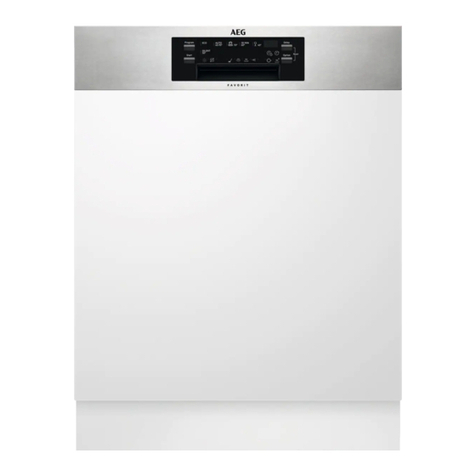
AEG
AEG FEE63800PM User manual
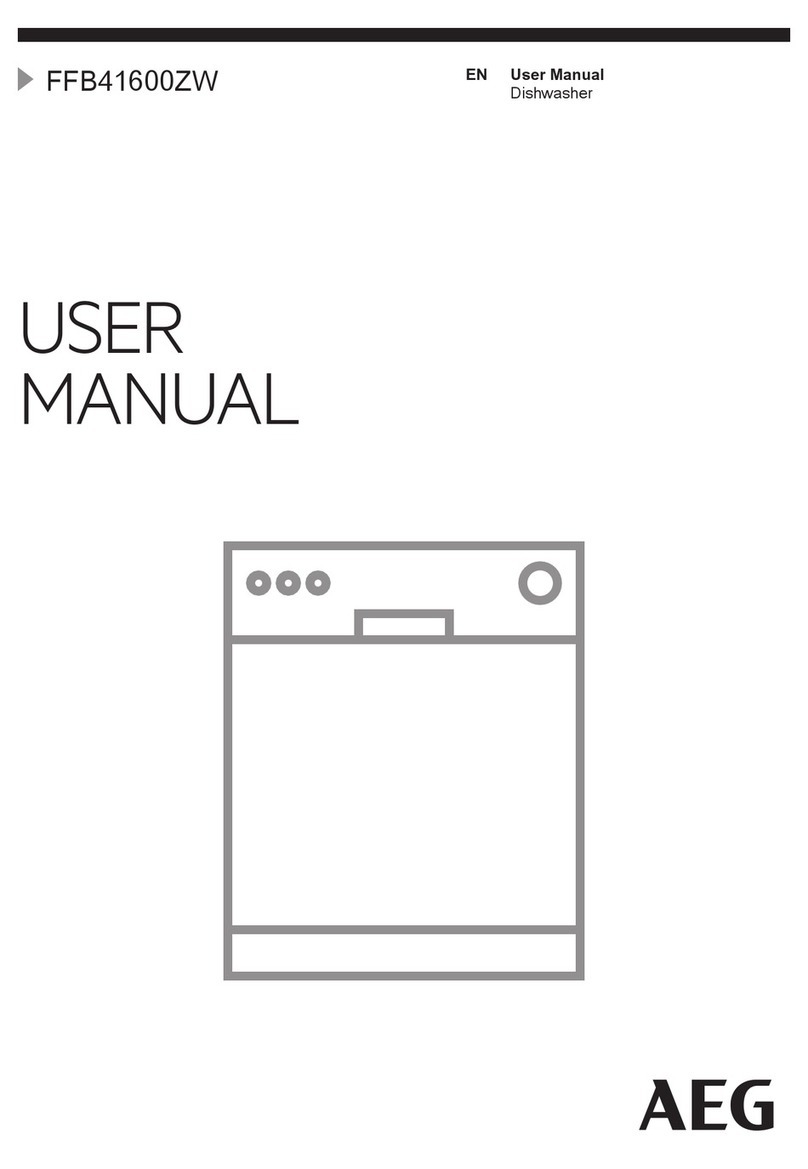
AEG
AEG FFB41600ZW User manual
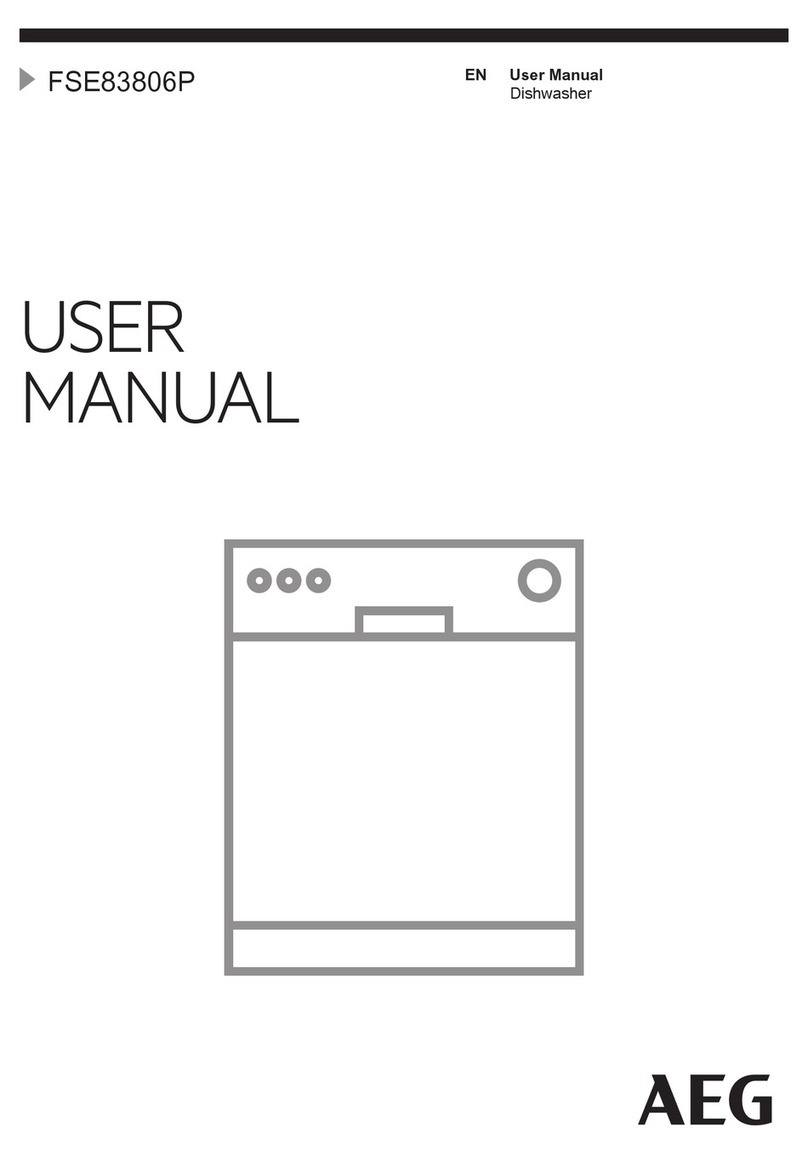
AEG
AEG FSE83806P User manual
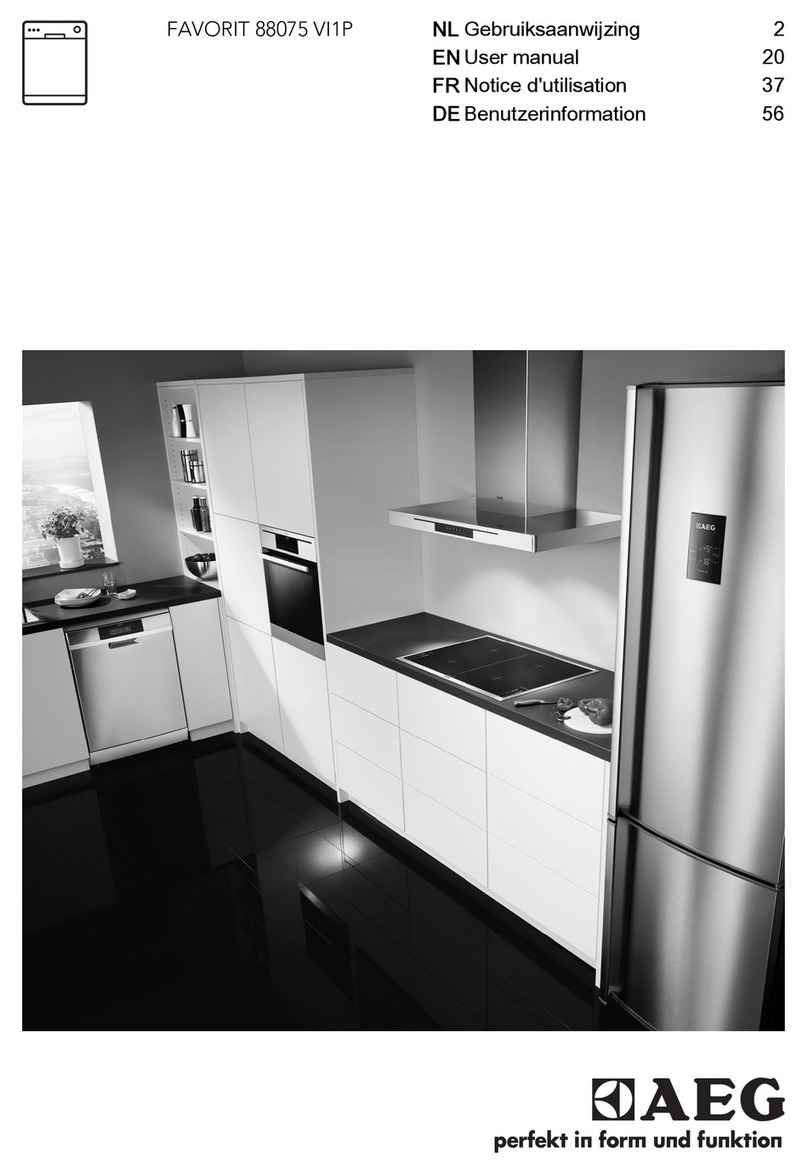
AEG
AEG FAVORIT 88075 VI1P User manual
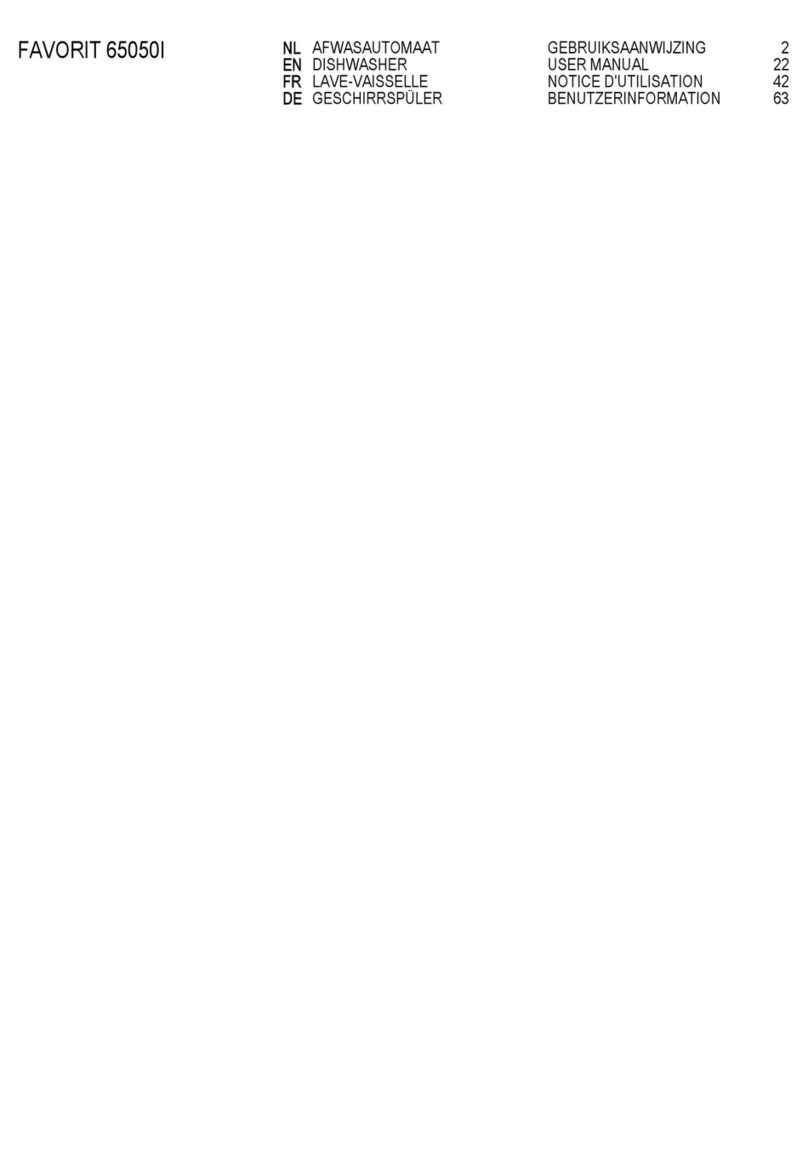
AEG
AEG FAVORIT 65050 i User manual
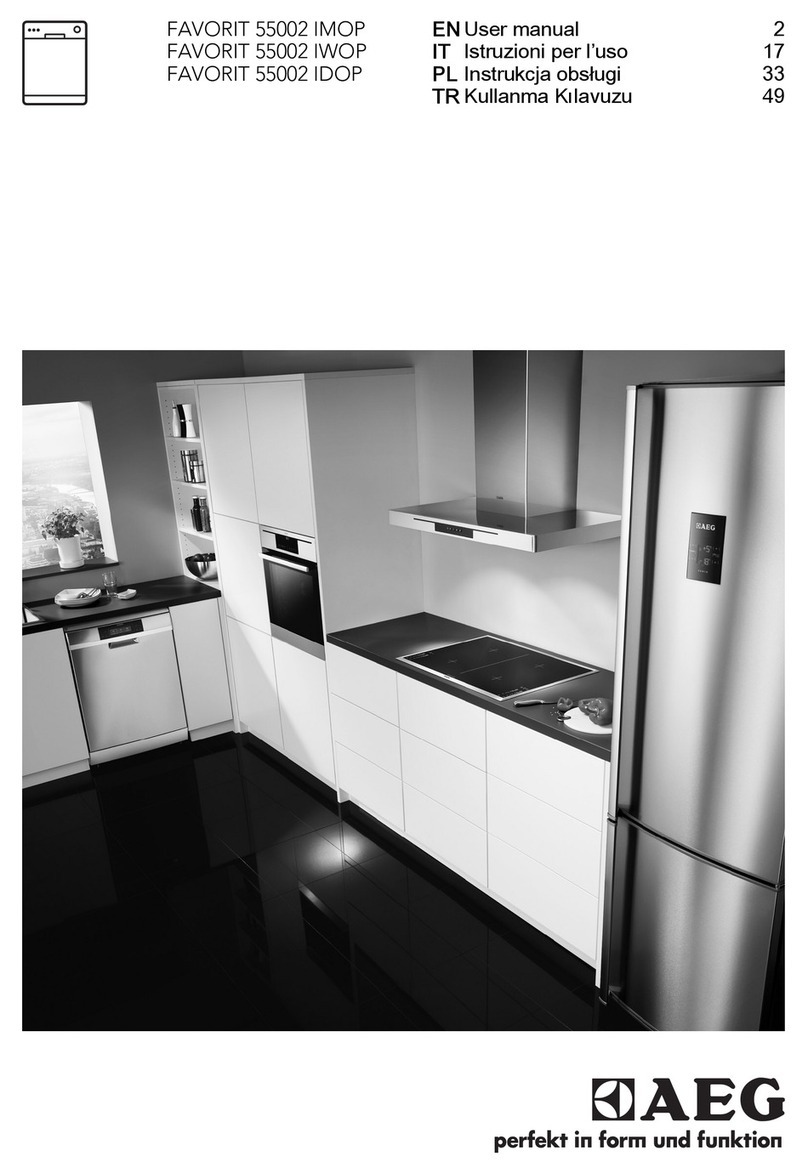
AEG
AEG FAVORIT 55002 IMOP User manual
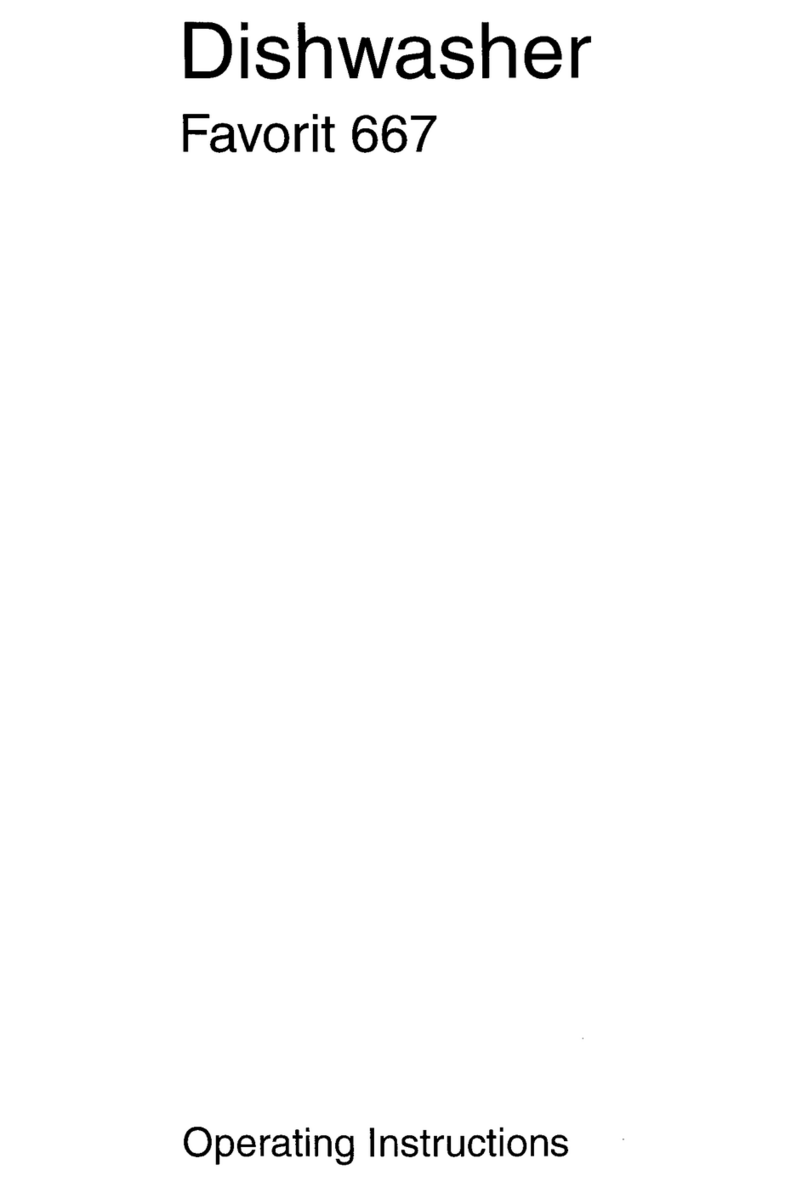
AEG
AEG Favorit 667 User manual

AEG
AEG FSE62600P User manual
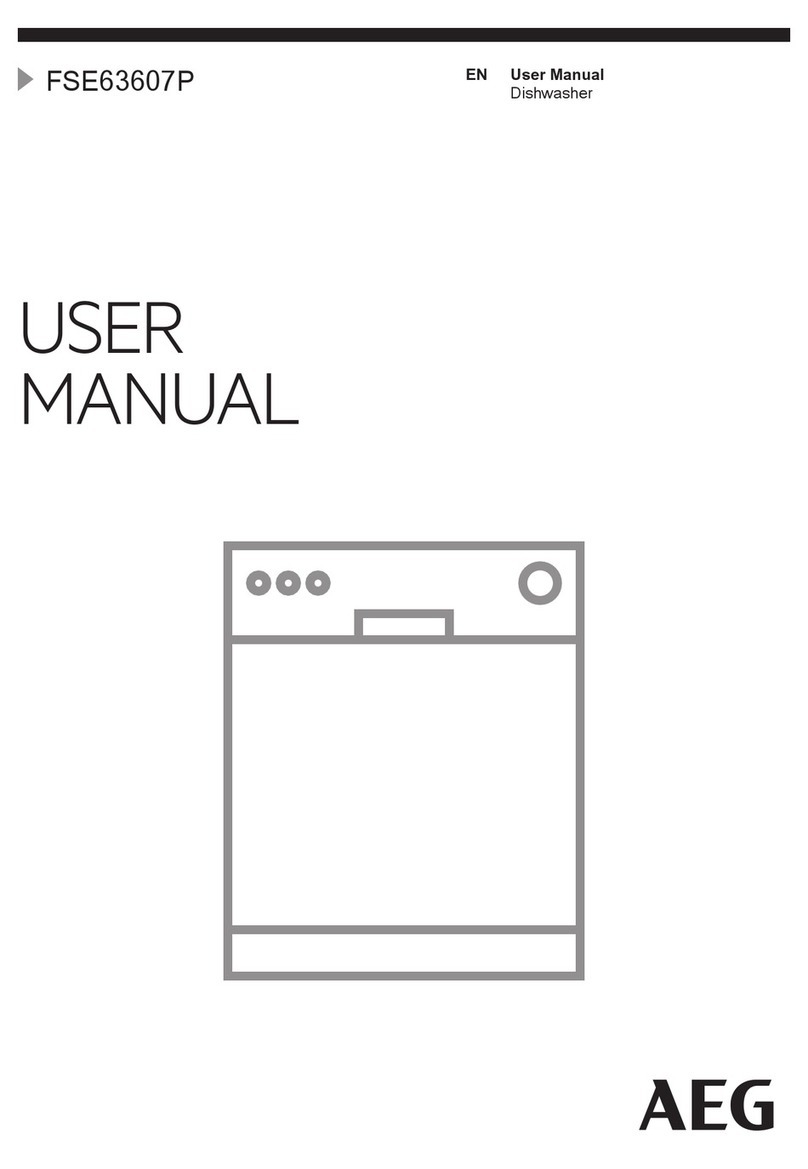
AEG
AEG FSE63607P User manual
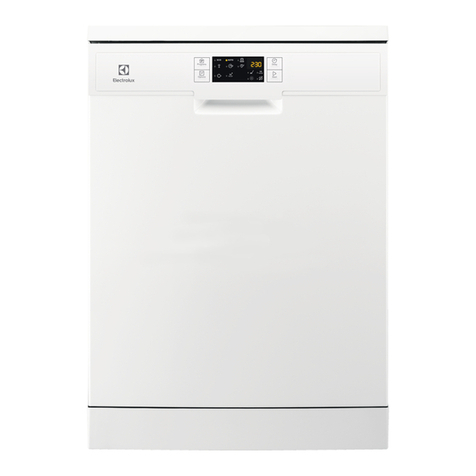
AEG
AEG ESF5512LOW User manual

AEG
AEG F89078VI-S User manual
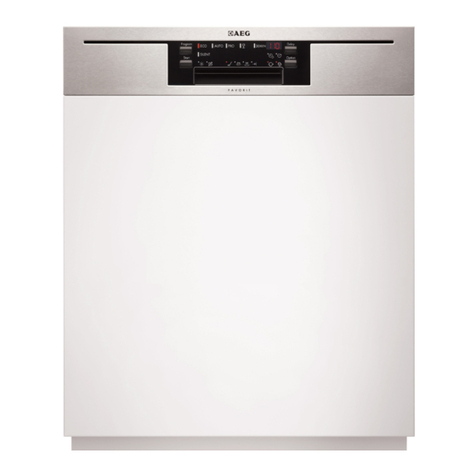
AEG
AEG FAVORIT 66602 IM0P User manual

AEG
AEG FAVORIT 40740 User manual

AEG
AEG FAVORIT 55020 User manual

AEG
AEG FAVORIT 88080 i Operation manual

AEG
AEG FAVORIT 45003 User manual
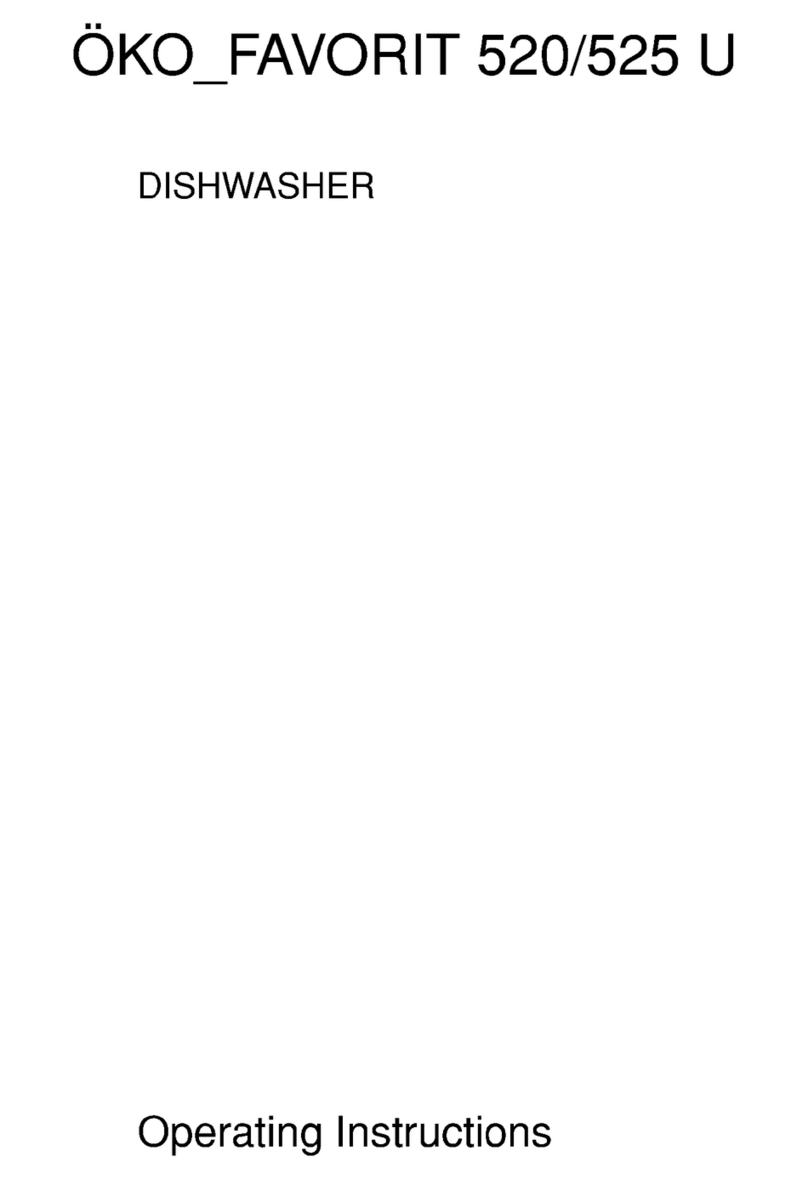
AEG
AEG OKO Favorit 520 User manual
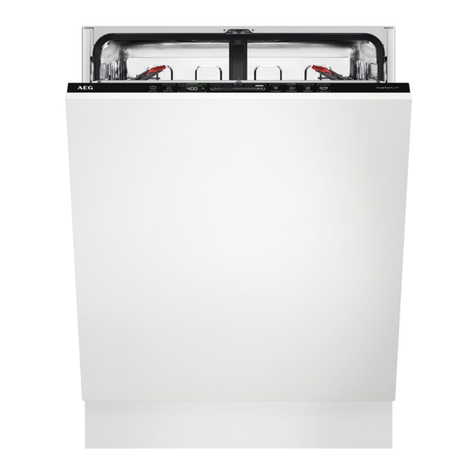
AEG
AEG FSE82827P User manual

AEG
AEG FSE72507P User manual

AEG
AEG 911436400 User manual
